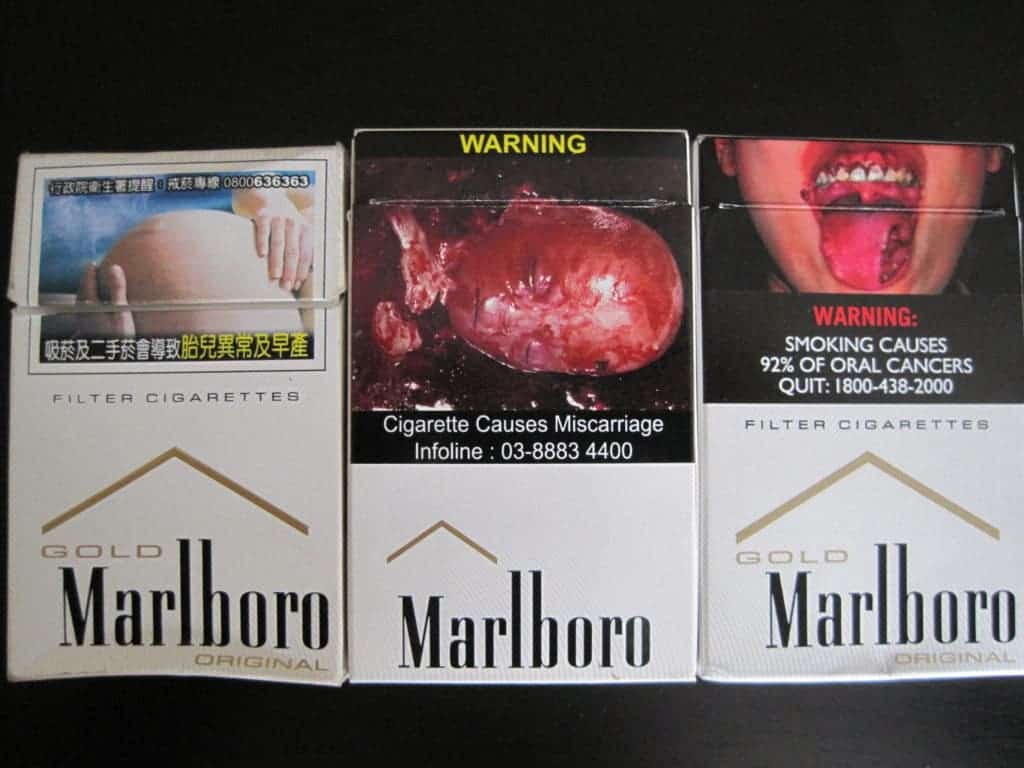
Despite the tobacco industry’s best efforts, today smoking is recognized as a health hazard and cigarette marketing is prohibited in most countries. Moreover, manufacturers are mandated to print labels that inform smokers that their health is gravely jeopardized by the habit. These warning labels are text-based, image-based or, as is most often the case, a combination of the two. At least 77 nations in the world use image labels to promote smoking cessation such as tarred lungs, ruined teeth or even dissected human corpses. The United States is not among them, however.
A new study suggests image labels are twice as effective than purely text-based labels at convincing people to attempt to quit smoking. The findings will prove important in substantiating the FDA’s upcoming new standards for tobacco produce labeling.
In 2011, the FDA was just about to roll out a series of pictorial warning labels for use on tobacco products as mandated by the Family Smoking Prevention and Tobacco Control Act (FSPTCA). The tobacco industry, however, succeeded in superseding the decision after it showed in court that the images planned to showcased on tobacco products were fictional. Namely, the diseased body parts and patients shown in the images were either computer generated or staged. Of course, these were based on real-life accounts of patients and deceased individuals as a result of smoking.
By a 2009 federal law, the FDA was supposed to release a final rule on graphic cigarette warnings covering the top half of the front and back of cigarette packs until June 22, 2011. Five years have already elapsed since the deadline but the American health agency has yet to deliver. In fact, it’s been assaulted on all fronts; on one hand, there’s the legal battles with the tobacco industry, on the other you have lawsuits started by public health and medical groups who are furious with the FDA’s postponements.
It’s important to mention at this point that the United States has not changed the standard textual warning in nearly 30 years, after becoming the first in the world in 1966 to require a warning label. That’s the same year the following commercial aired.
https://www.youtube.com/watch?v=V5SeBZSpnu0
Yup, it’s that long since an overhaul.
That being said, what the FDA has to do to implement graphic warnings for tobacco products is to avoid images that might be interpreted as opinion rather than fact. The FDA supposedly already has some genuine graphics depicting real cases prepared, but studies that support the use of images for preventing smoking in the first place will definitely help.
This is where the study prepared by researchers from the Penn Tobacco Center of Regulatory Science (TCORS) at the Annenberg School for Communication comes in.
“Our aim in this study was to find out how smokers respond to cigarette pack warning labels that use photographs of real people whose health has been affected by their own, or by someone else’s, smoking,” says the lead author Emily Brennan, Ph.D., David Hill Research Fellow at the Cancer Council Victoria in Australia.
Participants were asked to review several labels from one of three groups:
- labels that showed a photo of a real person who became harm as a result of smoking; some of these graphics were also accompanied by a short text description of the person involved in the image;
- the FDA’s previous warning graphics, the ones that were not allowed to be printed;
- text-only warnings, as currently in use.

After reviewing the cigarette packaging, the smokers were asked to describe their initial response and what their intentions to quit smoking were. Five weeks later, the team followed up and asked the recruits if they had made any attempts to quit and if so how successful they had been.
[ALSO READ] Chain-smoking robot lights up 12 cigarettes like a gatling gun for science
The findings were unambiguous showing image-labels outperformed the text-only labels.
Among the smokers who viewed the text-only labels, 7.4% of smokers attempted to quit in the subsequent five weeks. Those who viewed the testimonial photos from real smokers, however, had a quit attempt rate of 15.4%—roughly double—and were four times as likely to have been successful. Captions under the graphics, like “Terrie: Died from cancer at age 53,” did not provide any additional advantage.
“There’s a stickiness to the testimonial photos – the suffering of real people in real contexts – and they increased the likelihood that people would attempt to quit and stay quit,” says senior author Joseph N. Cappella, Ph.D
The graphics proposed by the researchers were equally as effective as the old graphics first proposed by the FDA five years ago.
“The use of testimonial images,” they write in the study, “may help to minimize how vulnerable the next iteration of warning labels in the United States are to legal challenges based on the factual nature of the messages.”
Besides warning labels, previous studies have shown that plain packaging (no glitter, no branding — all packs look the same) can also curb smoking.


